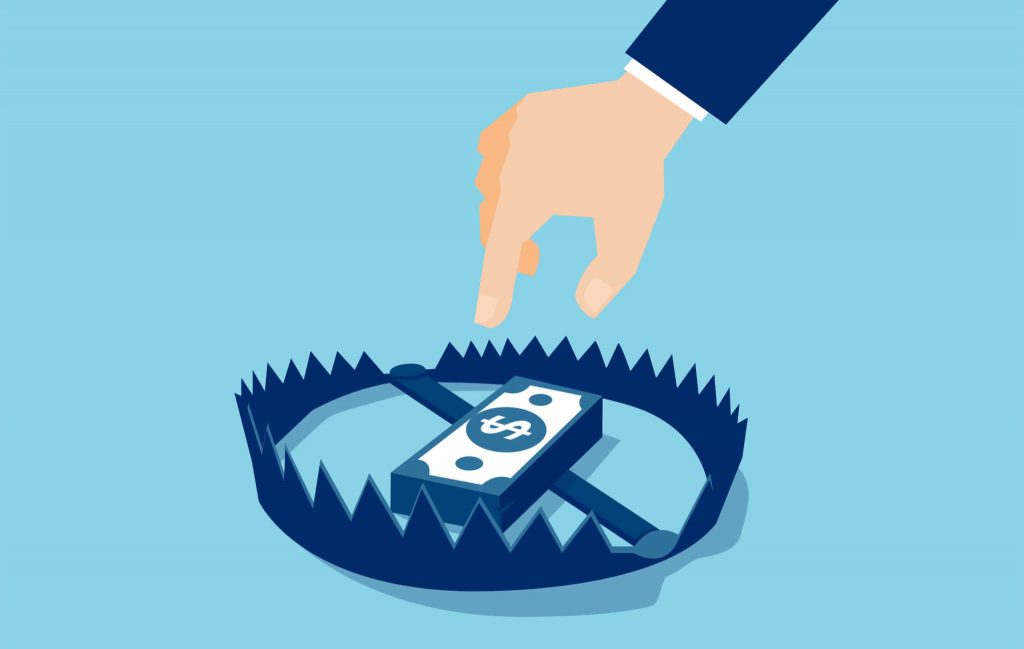
Recognizing and Avoiding Ponzi Schemes
In the modern finance world, there’s a ton to be concerned about, especially in the realm of security. As trading and investing rapidly shift towards the internet, shady businesses have more and more room to operate. The lack of a direct authority to control or punish such companies leads to them being strangely low risk. The heads of such companies often avoid any sort of punishment or consequence for their schemes. And until a better system of security arises, it’s on customers to take care of their own safety.
As an extension of that, we’d like to cover a famous type of scam, called a Ponzi scheme. Now, we should note that such tricks predate online investing and are in no way limited to it. In our eyes, that makes for a better lesson, as you can apply it more broadly than investing-specific advice. We’ll go over some famous tricks throughout history, as well as telltale signs of such scams. If you follow through, you should have quite a firm grasp on how to recognize and avoid Ponzi schemes.
The Characteristics
Naturally, we’ll start off our explanation of how to avoid Ponzi schemes by detailing what they are. Ponzi schemes are a type of scam that targets investors, financial or otherwise, into supporting a fraudulent service. The company, asset, or whatever the scammers use as a medium doesn’t exist in the real world. As such, the perpetrators actually sell you nothing while keeping the money you gave them.
That may sound like an unsustainable model to you, and you’d be right. If that was all there is to Ponzi schemes, they wouldn’t last for very long. However, there’s an additional step where scammers seek out further investors. They then use their funds to pay previous investors, maintaining the illusion of a valid business model. In this regard, Ponzi schemes bear a resemblance to Pyramid schemes, as both rely on constant victims.
However, the two still have enough differences to keep them distinct from each other. We’ll present the differences a bit later, as not to stray from our current topic. As we described, Ponzi schemes can last as long as there is a new row of investors to fund the previous one. Because of that, the ones carrying out the scam can find quite a bit of profit. Additionally, Ponzi schemes may not ask for massive investments from the victims.
Such cons are tricky to recognize and react to because it’s difficult to differentiate them from good ideas. Ponzi schemes can often look like valid business projects, especially for those outside the spheres they operate in. They can take various forms, such as fraudulent companies, high-interest rates in banks, or even financial assets. In the next section, we’ll present a guide on how to recognize the con in practice.
Recognizing Ponzi Schemes
Since their initial iterations, Ponzi schemes have become enough of an issue as to where they’ve been recognized by regulators. There’s been a ton of effort to inform and educate potential victims so they could avoid such tricks. The SEC or US Securities and Exchange Commission made such an effort by organizing a list of red flags. Here are some of the warning signs the SEC emphasizes as potential Ponzi scheme characteristics:
- Low-risk, high-return – One of the base characteristics of Ponzi schemes is that they’re too good to be true. Any investment carries a degree of risk, and someone promising guaranteed returns should set off alarm bells.
- Consistent profit – Any investment, be it in finance or business, has fluctuations. An investment that disregards market conditions and has consistent strong showings is worrying.
- Lack of regulation – Regular businesses, especially in the finance world, often ally themselves with regulators. That provides a degree of trustworthiness and customer safety. For apparent reasons, scammers avoid regulatory bodies.
- Cash-out difficulties – To keep fueling their schemes, scammers make it as difficult as possible to get your money out. Especially in Ponzi schemes, they’ll try and keep your money as long as they can.
- Paperwork inconsistency – Due to the absence of an actual business or asset, Ponzi schemes lack proper paperwork. You can find issues in legal papers or account statements.
- No licensing – US laws require licensing for financial professionals and their firms. Fake firms, naturally, don’t adhere to that.
- Secrecy and complexity – Ponzi schemes often either make their pitch needlessly complex or vague. Both ends of the spectrum serve to confuse potential victims.
Ponzi and Pyramid Schemes
As we said earlier, Ponzi and pyramid schemes have a ton of resemblances. For one, they both rely on aggressive marketing through non-traditional means. It’s rare that you’ll see a TV or YouTube advertisement for such a trick. Instead, they use word-of-mouth and social media promotion. The promoters can be borderline hostile, and these cons sometimes develop a cult-like following.
Additionally, another crucial quality they share is the unsustainability of their operations. Neither can last longer than they can find new victims. As the amount of money or customers needed for each subsequent level rises exponentially, the firms are guaranteed to fail.
The differences are a bit more nuanced. For example, Ponzi schemes require effort from the scammer and only an investment for the victim. Contrary to that, pyramid schemes require active engagement for those involved in the form of involving more people. Additionally, there’s often an actual product they promote and sell (albeit often faulty). In Ponzi schemes, the sustaining factor is a false promise and mysterious earnings.
Notable Ponzi Schemes
Ironically, the first recorded Ponzi schemes weren’t carried out by the man the con was named after. Namely, among the first recorded perpetrators, there was a German artist, Adelheid Luise “Adele” Spitzeder. She carried out a Ponzi scheme promising a high-return interest rate and then stealing the money. Sarah Howe repeated a similar trick in the US during the 1880s and served three years in prison for it.
Before practical examples of Ponzi schemes, the maneuver was present in the novel Martin Chuzzlewit by Charles Dickens. However, the first one that happened on a massive scale was by Charles Ponzi. The con man collected near $15 million by convincing victims to invest in international postal reply coupons.
More recent examples include scams by groups such as JSG Capital Investments. The group consisted of two men in California who promised quick profits by investing in pre-IPO stocks. As it is with Ponzi schemes, there were no actual investments.
The last one we would like to mention is important due to the sheer size of it, as well as the circumstances of its discovery. It was Bernie Madoff’s scheme that lasted for nearly two decades. The Wall Street broker ran a fraudulent wealth management business that ended up earning him around 20 billion. The con might have lasted even longer if Harry Markopolos, a whistleblower, didn’t reveal it.



